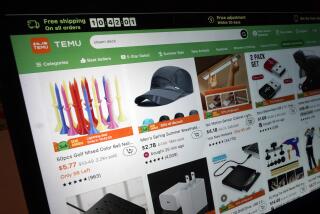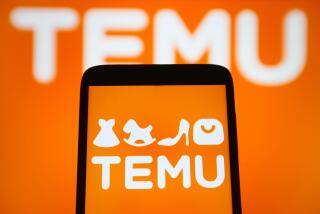Sock Makers Seek to Pare Chinese Imports
U.S. sock manufacturers, reeling from a steep surge in low-cost competition and plunging prices, Monday petitioned the Bush administration to restrict imports from China.
The U.S. Hosiery Assn. and three other textile groups said the nation’s sock industry had suffered “serious market disruption” from Chinese imports that had soared to 22 million dozen pairs last year from less than 1 million in 2001. Over the same period, the wholesale price of Chinese socks dropped to an average of $4.15 a dozen from $9, they said.
Monday’s filing is the latest move by U.S. manufacturers to curtail China’s growing clout in the American marketplace.
Though the sock industry is a small slice of the U.S. apparel and textile trade, employing 60,000 at 380 plants centered in the South, it could be influential in the presidential election.
The industry, along with other U.S. manufacturers, says China has an unfair advantage because of its cheap labor, government subsidies and an artificially weak currency that makes its exports less expensive.
The sock industry’s plight illustrates the challenges facing even the most efficient American manufacturers trying to compete against Chinese rivals. U.S. sock makers said they have done everything they could to cut costs and increase efficiencies, investing heavily in new labor-saving equipment and cutting 4,000 jobs over the last two years.
U.S. producers also took advantage of trade pacts that allowed them to ship labor-intensive sewing to Mexico and the Caribbean Basin, and bring the finished socks back without paying import duties.
Still, U.S. production declined to 166 million dozen in 2003 from 207 million dozen in 2001, according to the hosiery association. The U.S. share of the domestic market shrank to 40% last year from 76% in 1999, with much of that loss going to China, the group said. Though China has just under 10% of the U.S. sock market that share is growing quickly and the country is now the largest source of U.S. sock imports.
China’s surge stems from its entry into the World Trade Organization in 2001, which sparked a migration of manufacturing to that country, drawn by its low wages and efficient foreign-invested factories.
Meanwhile, the U.S. and other countries were starting to phase out a complex arrangement of quotas that restricted trade in textiles and apparel. That system is due to be eliminated by the end of this year.
When that happens, U.S. manufacturers argue, China will take over the world’s textile and apparel markets at the expense of as many as 3 million workers in other countries and the United States. The U.S. textile and apparel industry has asked the WTO to delay the phaseout of those quotas.
The sock industry’s petition was filed under a provision that China agreed to as part of its admission to the WTO. That measure allows the U.S. and other countries to impose emergency “safeguard” quotas on China’s textile and apparel goods if its exports surge. The Bush administration used that provision last year to restrict imports of Chinese-made bras, knit fabrics and dressing gowns.
The Commerce Department has 15 days to decide whether the sock industry’s petition meets legal requirements. If the petition is accepted, the government has 90 days to issue a final ruling.
The petition has a strong chance of being accepted, based on the sock industry’s loss of market share and China’s growth, trade experts said. But Dan Ikenson, a trade policy analyst at the Cato Institute in Washington, said the safeguard provision didn’t seriously threaten China’s producers because it allowed 7.5% growth on top of the latest year’s exports.
“That’s not particularly punitive,” he said.
Brenda Jacobs, counsel for the U.S. Assn. for Importers of Textiles and Apparel, said U.S. retailers weren’t too worried about Monday’s filing because the sock market represented such a small portion of the overall textile and apparel trade. If the U.S. government proceeds with restrictions on China, the likeliest winners will be other low-cost competitors in Asia or Latin America, she said.
“It’s hard to imagine that getting a restraint on China will change the fortunes of the U.S. sock industry,” she said.
But Charles Cole, owner of Alabama Footwear Inc., a sock manufacturer in Fort Payne, Ala., said limiting Chinese imports would buy some breathing room for U.S. manufacturers.
Cole said he had invested more than $3 million in new equipment in the last three years, allowing him to reduce his payroll without cutting production.
“If we had some controls on what comes from China, it would slow down a lot of companies moving out of the U.S.,” he said.
More to Read
Inside the business of entertainment
The Wide Shot brings you news, analysis and insights on everything from streaming wars to production — and what it all means for the future.
You may occasionally receive promotional content from the Los Angeles Times.










